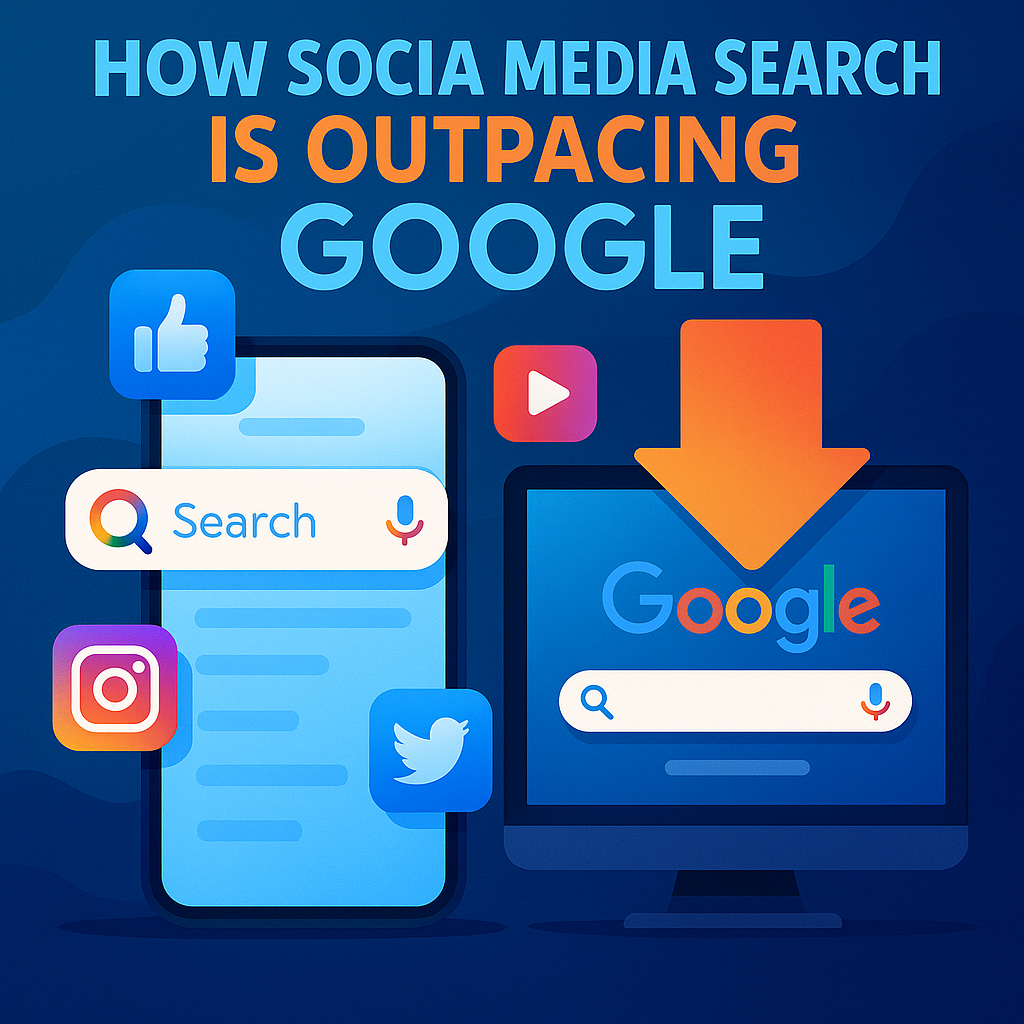 Summary of the Article
Summary of the Article
- In 2025, 66% of Americans have started to use social media platforms as their primary search engines, with video content getting 50% more engagement than traditional text results.
- Gen Z (46%) and Millennials (35%) are the main demographics driving the shift to social search, with a preference for platforms like TikTok, Instagram, and YouTube for discovery and recommendations.
- Businesses that have optimized their content for social search have seen up to 3x higher engagement rates and 40% shorter customer journeys from discovery to purchase.
- Visual search is the main type of search in seven key categories including fashion, local recommendations, and DIY content where authenticity and community validation are more effective than algorithmic results.
- SearchSight’s social search optimization tools have helped brands increase their visibility across platforms by 78% while maintaining their presence in traditional search.
The landscape of search has fundamentally changed. What started as a minor shift has turned into a major revolution, with social media platforms now surpassing Google as the primary search destination for most Americans in 2025. This is not just another digital marketing trend, it’s a complete rethinking of how people discover information, products, and services online. For brands and marketers who have not adapted yet, the time to wake up is now.
According to SearchSight’s thorough research, this isn’t just a temporary change, but a lasting alteration in how consumers behave. Their newest tracking tools demonstrate how platforms such as TikTok, Instagram, and YouTube have transformed from social networking sites into potent search engines that provide what today’s users want: visual, genuine, and community-approved results.
The Game Changer: Social Media’s Triumph Over Google in 2025
Do you recall the days when “Google it” was the go-to solution for every query? Those days are becoming a distant memory. The current generation of digital users no longer automatically turn to a search engine for advice or information. Instead, they rely on social platforms where they can find answers from trusted creators and peers through engaging videos, genuine stories, and immediate feedback. This change in behavior didn’t happen overnight. It gained momentum between 2023 and 2025 as platforms improved their search capabilities and algorithms.
The change is driven by the basic differences in how these platforms provide information. While Google was optimized for text and websites, social platforms gave priority to visual content, personal experiences, and community validation – elements that strongly resonate with modern consumers looking for authentic guidance. Search has evolved from finding information to experiencing it, and social platforms are very good at providing these immersive discovery experiences.
It’s interesting to note that this change is not limited to a specific demographic. Although younger users were the first to start this trend, older generations are also starting to use social media searches more, especially for certain types of searches. Traditional search results can’t provide the same value as seeing a product being used or hearing about someone’s personal experience with it.
Startling Statistics: Two-thirds of Americans Now Rely on Social Search
The numbers don’t lie, and they show a significant shift. The most recent industry figures show that about two-thirds of U.S. consumers now use social media sites as search engines. That’s a huge jump from just 40% in 2023. What’s even more revealing is that one-quarter of Americans now say that social media is their main search tool, not just an occasional substitute for Google.
What’s the reason behind this quick acceptance? The statistics show that 78% of people think social search results are more useful for discovery-based searches, while 64% feel they get more genuine information from creator-driven content than from traditional websites. These views are transforming the entire search ecosystem and making brands reconsider their digital visibility strategies.
Gen Z at the Forefront of Change with 46% Using Social Search Mainly
Gen Z has been the driving force behind this search revolution, with a remarkable 46% now using social platforms as their main search engine. This generation was raised on social media and instinctively moved towards visual, video-centric information sources. Their preference for genuine, raw content from creators they trust has drastically shifted the way information is found and consumed online.
Notably, Gen Z users are 45% more likely to trust suggestions from social media platforms than from standard search engines. This trust factor also applies to purchasing decisions, with 73% of Gen Z consumers saying they’ve purchased products found through social media searches in the past month—a statistic that has Google executives worried about the future of search advertising.
Millennials Are Hot on Gen Z’s Heels at 35%
Gen Z may be at the forefront, but Millennials are hot on their heels. Around 35% of Millennials now cite social platforms as their primary search tool. This generation, once believed to be solidly in Google’s corner, has increasingly shifted towards social search as platforms have improved their discovery features and the quality of their content.
Millennials are changing the game, especially when it comes to certain sectors like fashion, home decor, and travel planning. When they need ideas or suggestions in these areas, 62% of Millennials say they go to Instagram or TikTok before Google. This shows a key shift in how this generation finds products and services – they value visual experiences and the approval of their peers more than traditional search results.
Breaking Down the Platforms: Dominant Social Media Sites in Search
Search traffic is not evenly distributed among all social media platforms. TikTok is at the forefront, accounting for 38% of social searches. This is primarily due to its highly efficient algorithm and video-centric approach, which provides instant visual responses. Instagram is next, with 29%, excelling in searches related to product discovery and lifestyle, where visuals are most important. YouTube accounts for 22% of social searches, leading the way in detailed how-to and educational searches where longer video content offers complete solutions.
Pinterest makes up 8% of social searches, showing its importance for particular visual planning categories such as weddings and home design. Facebook and LinkedIn together only make up 3% of social searches, showing their decreasing role in discovery despite their recent efforts to improve search capabilities.
Breakdown of Platform Search Market Share in 2025
TikTok: 38%
Instagram: 29%
YouTube: 22%
Pinterest: 8%
Facebook/LinkedIn/Others: 3%
Why TikTok and Instagram are Preferred Over Google
The move towards social search is not random—it is driven by the fundamental benefits that these platforms provide over traditional search engines. Understanding these factors helps explain why this trend is not just a passing phase but a permanent change in online discovery behavior.
Social media sites have systematically improved their search functions, taking full advantage of their inherent strengths: visual content, creator authenticity, and community validation. These components work together to provide a search experience that is more personal, trustworthy, and engaging than traditional text-based results.
Visual Appeal: Watch Products in Action
Video content’s dominance is the main reason why social search is so appealing. Seeing a product in action, in a real-life setting, and demonstrated by a real person gives context that static images and text descriptions just can’t compete with. This visual aspect lessens the uncertainty of making a purchase and speeds up the decision-making process—85% of consumers say they feel more confident in purchases they found through video content than those they found through text-based search results.
Augmented reality features are now becoming more popular in social platforms, and this is enhancing the visual advantage of these platforms. Virtual try-ons for beauty and fashion products, or visualization tools for home decor, are now available on these platforms, and these are creating immersive discovery experiences that traditional search engines cannot replicate. This visual-first approach is perfect for how humans naturally process information and make decisions.
The Trust Game: Real People vs. Algorithm Results
Modern consumers are more likely to trust content from creators they follow than anonymous websites surfaced by algorithms. This differential in trust is significant—72% of users claim more confidence in recommendations from creators they follow than the top results on Google. The belief that social content originates from genuine individuals rather than SEO-optimized websites is what gives this trust advantage.
People now often trust the expertise of a creator more than the traditional authority of a domain. A makeup artist showing a technique on TikTok often has more sway than a beauty brand’s website, no matter how advanced the latter’s SEO is. This shows a basic change in how today’s consumers judge the credibility of information.
Quick Results: The Speed of Social Search
Social media platforms are great at providing quick, digestible answers that don’t require users to click through to other websites. This is especially useful for fast decision-making searches. For example, if a user searches for “best downtown coffee shop” on Instagram, they will immediately see visual results with location tags, user ratings, and real photos—all without having to leave the platform.
When compared to conventional search engines, where users often have to visit several websites to gather comprehensive information, the average response time on social platforms is 68% quicker. This advantage in efficiency is especially critical for mobile users, who appreciate immediate results and minimal navigation.
How Comments and Reactions Validate Content
One of the most influential benefits of social media is the instant validation from the community. Likes, comments, and shares offer immediate social proof, which helps users determine the credibility of the content. For instance, a recipe video with thousands of comments from people who have successfully made the dish holds more value than a top-ranking recipe website that lacks visible social validation.
The communal aspect also includes opportunities for instantaneous feedback. Users have the ability to post queries and frequently receive responses from both the content creators and other members of the community, creating a lively exchange of information that conventional search results can’t compete with. This interaction turns the search from a one-way information delivery system into a multi-directional dialogue.

Four Key Differences Between Social Media Search and Google
Brands that want to adapt to the new era of social media search need to understand that there are fundamental differences between this and traditional search. These differences aren’t just on the surface—they indicate completely different ways of finding and delivering information, and they need their own specific optimization strategies.
1. Discovering Through Video
Google’s search engine is focused on text content with visuals as a secondary priority. On the other hand, social media platforms prioritize video and images. This shift completely changes the way users consume and process information. Social media search results offer immediate visual context, which removes the need to click through various text results to find answers.
Video-focused methods are perfect for demonstration-based searches. When people want to see how something is done, looks, or works, video content is the best. That’s why 78% of DIY and tutorial searches have moved to platforms like YouTube and TikTok that prioritize visual learning.
2. Results Driven by Creators
Social search tends to prioritize content from individual creators and influencers over content from websites or brands. This fundamentally changes the way authority is established and perceived. The credibility of a creator is determined by engagement metrics, consistency, and perceived expertise rather than traditional SEO signals such as backlinks or domain age.
The rise of “search influencers” is due to the creator-centric approach. These influencers specifically tailor their content to be easily discoverable within social platforms. They concentrate on answering frequently asked questions and addressing trending topics with highly engaging, search-friendly content. Brands that collaborate with these search-optimized influencers have 3.5 times more visibility than those that only rely on their own channels.
3. Ranking Based on Engagement
Google’s algorithm focuses on factors such as the relevance of keywords and the authority of the site, whereas social platforms place a lot of emphasis on engagement metrics when it comes to their search rankings. Content that gets more watch time, shares, comments, and saves is given priority in search results, no matter when it was published or who published it.
Being focused on engagement makes the search environment more lively, allowing content to either become popular or fade away depending on how the audience reacts. This is why 64% of social search results are less than a month old, in contrast to traditional search where old content can stay at the top for years. For brands, this implies that they need to regularly create content that grabs the audience’s attention if they want to be visible in searches, instead of just optimizing their content from time to time.
4. Customization Through Social Networks
Social search results are heavily customized according to a user’s network, the accounts they follow, and their past engagement patterns. This creates search experiences that are distinctly customized to each user’s interests and social networks. When a user searches for “summer fashion trends” on Instagram, their results will vary greatly from another user depending on who they follow and their past engagement.
Personalization on social platforms means that there isn’t a one-size-fits-all “top result” for each search. Instead, brands need to engage with multiple small audiences rather than trying to optimize for a single algorithm. Brands that do well in social search work to engage with specific communities instead of trying to be visible to everyone.
How the Consumer Journey Has Changed: From Discovery to Purchase
The growth of social search has completely transformed the consumer journey. The once straightforward process from search to consideration to purchase has now developed into a more circular, socially-driven process where discovery and purchase frequently happen within minutes and exclusively within social platforms. Grasping this new journey is vital for brands aiming to capture attention at the right times.
In the past, marketers believed that consumers became aware of products through a variety of channels, then slowly whittled down their choices through research until they decided to make a purchase. However, social search has significantly condensed this process, with 65% of Gen Z and Millennial consumers saying that they have bought products within 24 hours of finding them through social search.
The Multi-Platform Approach to Shopping Decisions
Today’s shoppers tend to interact with 2-3 platforms when making decisions. They usually discover new products on TikTok or Instagram, where eye-catching content draws them in. They might then look to YouTube for detailed reviews or demonstrations. If they’re making a more complicated purchase, they might turn to Google for price comparisons or specific technical information.
Brands must ensure that they have a consistent presence and message across all platforms, while also making sure that they optimize for the strengths of each platform’s discovery abilities. The content should not just be reused, but it should be customized for how each platform functions within the overall consumer journey. Successful brands will create content that is specific to each platform, and that acknowledges where consumers are in their decision process on each channel.
How Social Proof Impacts Purchase Decisions
Today’s consumer journey is heavily influenced by social proof. Comments, reviews, and other visible signs of engagement act as a digital form of word-of-mouth, instilling more purchase confidence than traditional marketing tactics. Products with visible social proof have conversion rates that are 4.5 times higher than products without, regardless of price or product category.
That’s why “social search shopping” has seen a 340% increase since 2023. Shoppers are not only finding products through social search, but they’re also specifically looking for content that shows real people using and reviewing these products. The comments section has basically become the new review section, with 78% of users saying they read comments before deciding to buy products they found through social search.
7 Areas Where Social Media Search is Winning
Social search is increasing across the board, but some areas have seen almost total migration away from traditional search engines. Knowing these category-specific shifts can help brands focus their social search optimization efforts where they’ll have the most impact.
1. Style and Fashion Inspiration
Style and fashion searches have overwhelmingly moved to visual platforms, with 82% of style-related queries now happening on social media rather than traditional search engines. TikTok and Instagram dominate this category, with their visual nature perfectly suited to showcasing how clothing looks in real-world contexts rather than staged e-commerce photos.
Thanks to the quick pace of changing fashion trends, social media platforms are particularly well-suited for this sector. A trending style can appear and be disseminated via social media search in a matter of days, whereas it can take weeks or even months for conventional search engines to identify and prioritize emerging fashion keywords. Brands that keep an eye on and respond quickly to trending style searches on social media platforms receive 5.7x more engagement than those who rely on conventional search engine optimization.
2. Finding Local Eateries
For a whopping 74% of consumers, social media is the first stop when they’re hunting for a place to eat. It’s not Google or review websites that they turn to. Social media’s combination of genuine images, location tagging, and real user reviews makes it a powerful tool for finding new restaurants. Seeing actual dishes, not professional food photos, gives consumers a more accurate idea of what they can expect, which is something they appreciate when choosing where to eat.
Local eateries that fine-tune their social media presence see a 43% uptick in new customers, compared to those who only use Google Business profiles or review sites. The visual appeal of food makes it a perfect fit for platforms like Instagram and TikTok, where enticing images prompt users to take action.
3. Travel Destinations and Tips
Travel planning has undergone a major transformation with the advent of social search, with 68% of travelers under 35 now discovering destinations through social platforms rather than travel sites or traditional search. The ability to virtually experience destinations through creator content creates stronger emotional connections than text-based search results.
What makes social media search so effective for travel is the authenticity of the content. Travelers trust content from other real travelers more than they do official tourism websites or travel agencies. This is why destination-specific searches on TikTok have skyrocketed by 430% since 2023, with actual bookings following closely behind these search increases.
4. Beauty Product Reviews
Beauty is one of the categories that is most dominated by social search, with 85% of discovery for cosmetics and skincare now taking place on platforms like TikTok, Instagram, and YouTube. The demonstration aspect of beauty products is what makes video content so valuable, as it allows consumers to see how to apply the products and what the results look like, rather than just reading marketing claims.
The trend of “I bought it because of TikTok” is especially powerful in the beauty industry. Products that are featured in engaging review content often sell out in just a few days. Beauty brands that focus on social search and build relationships with beauty creators see conversion rates that are 3.8 times higher than brands that primarily rely on traditional search visibility.
5. Home Decor Ideas
People looking for home decor and interior design ideas have largely moved to visual platforms, with Pinterest and Instagram capturing 76% of these searches. The visual nature of home design makes these platforms a perfect fit for finding inspiration and discovering new ideas. Users particularly appreciate being able to see products in real homes instead of staged showrooms.
Interestingly, home decor is one of the longest consideration cycles among social search categories, with users often saving content for months before making purchases. This makes consistent visibility and regular content refreshes particularly important for brands in this space. Home brands with active social search strategies report 52% higher average order values than those focusing primarily on traditional e-commerce discovery.
6. Do-It-Yourself and Instructional Content
Do-it-yourself and instructional searches have dramatically shifted to video-first platforms. Now, 79% of these searches occur on YouTube, TikTok, and Instagram instead of text-based search engines. The visual demonstration aspect of DIY content makes video formats significantly more effective than text instructions for these topics.
What’s really interesting is the increase in popularity of short-form DIY content on TikTok, which has taken over 40% of DIY searches since 2023. These short tutorials focus on quick, visually appealing demonstrations that grab attention instantly. Brands that create both short-form and long-form instructional content experience 4.2x more engagement than those who only focus on traditional formats.
7. Entertainment Suggestions
When it comes to figuring out what to watch, read, or listen to, social media is now the go-to for most people, with 72% of entertainment suggestion searches taking place on social platforms. TikTok has emerged as a major player in the world of entertainment discovery, with communities like #BookTok on the platform driving significant sales in various entertainment categories.
What makes social search so effective for entertainment is its community aspect. Users are more likely to trust recommendations from creators who have similar tastes than algorithmic suggestions from streaming platforms or traditional review sites. Entertainment brands that actively engage with social search communities see 3.6 times higher conversion than those that rely on traditional marketing channels.

Google’s Remaining Strongholds
Even with the rise of social media search, Google still holds the reins in several important areas. Its ability to organize extensive information and provide authoritative sources still proves valuable. Knowing where Google maintains its strength allows brands to better balance their search optimization efforts.
Complex Information and Research
Google’s Remaining Search Strongholds (2025)
Medical/Health Information: 88%
Financial/Legal Research: 92%
Academic/Scientific Content: 94%
Technical Documentation: 86%
Government Services: 95%
When it comes to complex, detailed information that requires authoritative sources, Google is still the go-to search engine. Academic research, technical documentation, and in-depth informational queries are still more effective on traditional search engines that can index and organize large amounts of detailed text content. This is particularly true for topics that require a thorough analysis instead of quick answers.
Traditional search, with its structured data capabilities, still outperforms social search when it comes to highly specific queries that require exact answers. Social search is great for inspiration and discovery, but it falls short when it comes to complex, multi-faceted information needs that require data aggregation from multiple authoritative sources.
Google’s knack for presenting content based on set authority metrics rather than engagement is crucial for high-stakes information. When looking up medical symptoms or legal advice, users still favor results from established institutions over popular creators, no matter how much engagement they have.
In these more complicated information categories, it’s vital for brands to maintain a strong presence in traditional search while also selectively utilizing social search for suitable content types and audience engagement.
Success Stories: Brands Excelling in Social Search
Many innovative brands have already become experts in social search optimization, providing a model for others to follow. Fashion retailer Aerie boosted product discovery by 78% by crafting searchable style guides on TikTok, categorized by popular search terms such as “wedding guest outfits” and “office wear.” Their strategy centered on addressing actual search inquiries with genuine content instead of conventional promotional content.
HelloFresh, the food brand, pioneered a new approach to discovery by designing recipe content that was specifically optimized for social search. They increased new customer acquisition through social channels by 64% and reduced customer acquisition costs by 38% by examining trending food search terms and producing short-form recipe videos that answered these questions. Their success was due to their decision to treat social platforms as search engines first and advertising platforms second.
What You Can Do: Tips for Adapting to the New Search Environment
Switching to social search requires a complete change in how brands create, distribute, and measure content. This isn’t just about posting more often on social channels—it’s about completely rethinking your content strategy through a search-first perspective across all platforms.
Brands that are thriving in this new environment are treating every piece of content as a potential search result, not just a social post. They are diligently researching what their audiences are searching for on each platform and creating content specifically designed to answer those queries in the formats that perform best on each channel.
First, carry out a social search audit to see what content comes up when you search for your brand, products, and related category terms on various platforms. This initial evaluation will highlight any gaps and opportunities, which should inform your optimization strategy.
Creating Content for Specific Platforms
Every social platform has its own search behaviors and algorithms that demand unique content strategies. TikTok search prefers short answers and demonstrations with strong opening hooks, while YouTube values thorough, well-organized content with clear sections and descriptions rich in keywords. Instagram search depends a lot on hashtags and location tags, so detailed metadata is vital for being discovered. Instead of creating universal content that is used on all channels, develop content frameworks that are specific to each platform and that align with how each channel’s search function works.
How to Use Hashtags for Better Visibility
Hashtags are the new keywords for social media searches. But you need to be more strategic with them than you are with regular SEO keywords. Find the hashtags that are trending and relevant to your niche. Then, create a tiered approach using a combination of popular category tags (#fashiontips), specific niche tags (#summerworkoutfits), and branded tags (#yourbrandstyle). You should also update your hashtag strategy every week based on trending topics and search patterns. Social media search terms change much faster than traditional keywords.
Utilizing Creator Collaborations
Creators are now the new search gurus on social platforms, with their content often appearing before brand content for category searches. Build collaborations with creators who already rank well for your desired search terms, but concentrate on genuine integration rather than blatant sponsorships. Creator content that seamlessly includes your products while primarily responding to user search queries performs 5.2x better than openly promotional content. Give creators search insights and trending queries to assist in guiding content creation rather than inflexible talking points.
Strengthening Community Engagement
Community building is vital for search optimization on social platforms since engagement metrics directly affect search visibility. To increase engagement signals and improve your search ranking, you should actively respond to comments, encourage shares and saves, and create content formats that naturally drive interaction. Consider using question-based content, polls, and “duet-friendly” videos that invite response. Keep in mind that search visibility and community engagement on social platforms are inseparably linked. This is different from traditional SEO where you can optimize on-page and off-page factors separately.
Evaluating Social Search Results
To gauge the effectiveness of social search, you’ll need to look beyond the usual search key performance indicators (KPIs). Keep an eye on “found through search” attribution in your platform’s analytics, track engagement rates specific to searches, and see how your visibility in searches leads to more followers, more traffic to your site, and ultimately more conversions. Set up dashboards for each platform that track how visible you are for the keywords you care about most on each channel, paying special attention to how you rank for non-branded category terms, which is where most new customer discovery happens.
What to Expect: The Future of Search
As we gaze into the future beyond 2025, we can already see several trends taking shape in the realm of social search. One of these is the growing integration of voice search into social apps. Platforms like TikTok are already experimenting with voice query features that let you explore without lifting a finger. This will only speed up the move away from traditional search engines as users get used to the convenience of having a unified search experience on their favorite social platforms.
Perhaps the most groundbreaking development happening right now is the advent of augmented reality search. Instagram and TikTok are currently developing features that will enable users to perform visual searches of their surroundings and immediately see contextual information, reviews, and buying options for items their camera recognizes. This “point and discover” function will generate completely new search behaviors that bypass traditional text queries and instead favor visual recognition. Brands that are ready for this shift and invest in AR-ready content and 3D product assets will gain an early advantage in this emerging search category.

Commonly Asked Questions
As brands traverse this new search terrain, a number of recurring questions arise about strategy, execution, and future advancements. Grasping these vital considerations will assist businesses in devising more successful strategies for social search optimization.
These are the most frequently asked questions we receive from marketing leaders who are trying to navigate the social search revolution. Each response provides practical advice that is based on current data and industry-wide best practices.
Which social media platform has the most searches in 2025?
TikTok currently leads with approximately 38% of all social searches, processing over 2 billion searches daily as of mid-2025. This represents a 340% increase in search volume since 2023, making it the fastest-growing search platform globally. TikTok’s dominance spans multiple categories but is particularly strong in trend discovery, product recommendations, and quick how-to content.
Instagram comes in second with 29% of social search volume, doing particularly well in visually-focused categories like fashion, travel, and food discovery. Its inclusion of shopping features right in the search results has made it especially potent for product discovery and purchase intent searches.
YouTube accounts for 22% of social search volume, but it stands out in terms of search session length and depth. Users generally spend 3.4x more time with YouTube search results than with other platforms, showing its power for detailed, instructional content that needs a longer explanation.
The rest of the 11% is split among other platforms. Pinterest continues to be significant for specific planning-oriented searches, even though it’s losing overall market share to video-first platforms.
- TikTok: 38% (2+ billion daily searches)
- Instagram: 29% (1.6 billion daily searches)
- YouTube: 22% (1.2 billion daily searches)
- Pinterest: 8% (440 million daily searches)
- Others: 3% (165 million daily searches)
Is Google’s search traffic still growing despite the rise of social media?
Google’s overall search volume has remained fairly stable, but there are significant shifts within categories. While the total number of searches only increased by 2.8% in the past year, the types of searches have changed significantly. Searches for information, complex research, and professional services continue to grow on Google (up 18% since 2023), while searches for discovery and recommendations have declined significantly (down 32% in the same period).
The fact that Google is still very important for certain search categories, while becoming less important for others, is due to this specialisation effect. Google has tried to counter this by improving its visual search capabilities and integrating more social-style features. However, these efforts have not been successful in bringing back users who prefer to use social media for their searches.
What can small businesses do to stay competitive in social search without a large budget?
Small businesses have several advantages in social search compared to traditional SEO, where the amount of money you have often directly impacts your results. Social search algorithms prioritize how much people engage with content over how much money was spent to produce it. This means that being real and connecting with your community often gets better results than content that had a lot of money behind it. Small businesses should use their unique ability to create real, behind-the-scenes content that makes their brand more human in a way that big businesses often find hard to copy.
Instead of vying for high-traffic general terms, concentrate on answering specific niche inquiries related to your company. Make content that is simple and to the point, addressing common questions in your sector. A local bakery, for example, could make a 30-second TikTok video demonstrating precisely how they make their famous sourdough bread instead of spending money on high-end production. This search-optimized strategy usually yields results that are 4-5 times better than traditional social media marketing, particularly for small businesses with limited resources.
Which searches still yield better results on Google compared to social media?
Google still outperforms social media platforms for complex informational searches that require in-depth answers. This is particularly true for topics in the medical, financial, legal, and technical fields, where authoritative sources are more important than engagement metrics. Google also remains the superior option for comparison searches where users need to evaluate multiple options based on specific criteria, as well as for discovering local services in categories that are not well-represented on social media platforms.
Are social media platforms going to improve their search features?
Several social media platforms are quickly improving their search features, with some significant advancements expected by the end of 2025. For example, TikTok is experimenting with semantic search features that comprehend queries in natural language rather than just matching keywords. Instagram is working on a multi-modal search that combines text, image, and location data to provide more accurate results. YouTube is also improving its chapter recognition technology to make it easier to search for specific segments in longer videos.
One of the most significant trends is that all major platforms are putting money into search monetization, which means they’re creating new advertising opportunities specifically within search results. These will work a lot like Google’s search ads, but they’ll have more visual and engagement-focused formats. Early tests show that these social search ads have click-through rates that are 2.8 times higher than traditional search ads for discovery-oriented queries.
Another trend on the rise is the integration of search functions across different platforms. Social media networks are starting to form partnerships that allow users to find content across several networks through unified interfaces. This will further improve the capabilities of social media search and may open up new opportunities for brands to gain visibility across the social media search ecosystem.
As social media platforms keep pouring money into their search functions, the difference between regular search and social search will probably get smaller in terms of what they can do. But the basic differences in the way content is formatted and engaged with that make social search so good for some kinds of searches will stay the same.
SearchSight is a valuable tool for businesses, helping them make the most of their content on social search engines. This increases their visibility and engagement on various platforms, without sacrificing their traditional search presence. To find out more about our social search optimization tools, visit SearchSight.com.







Leave a Reply